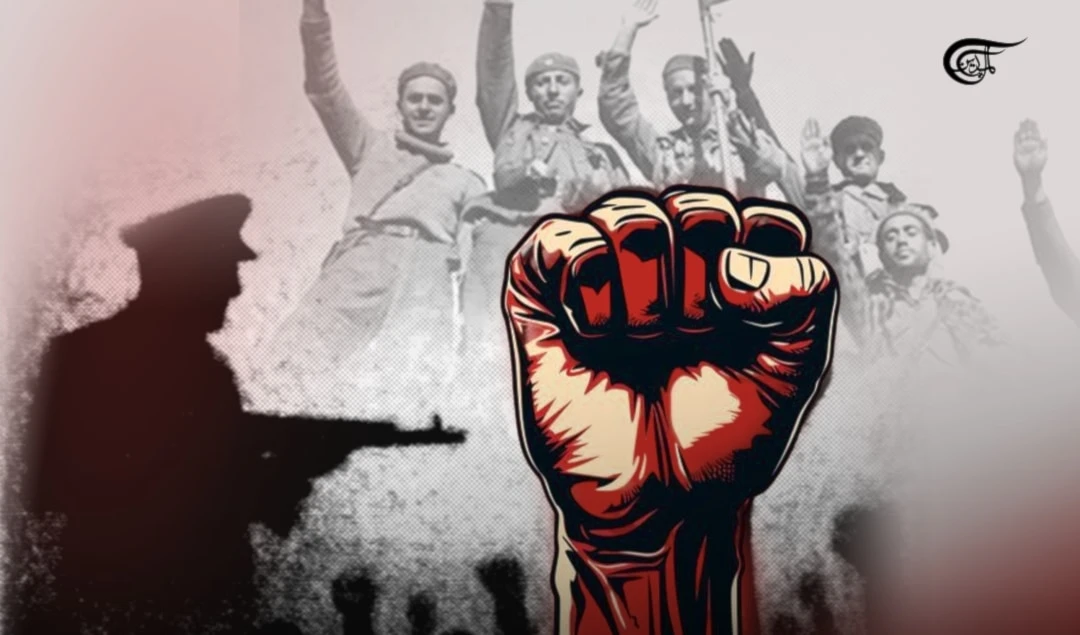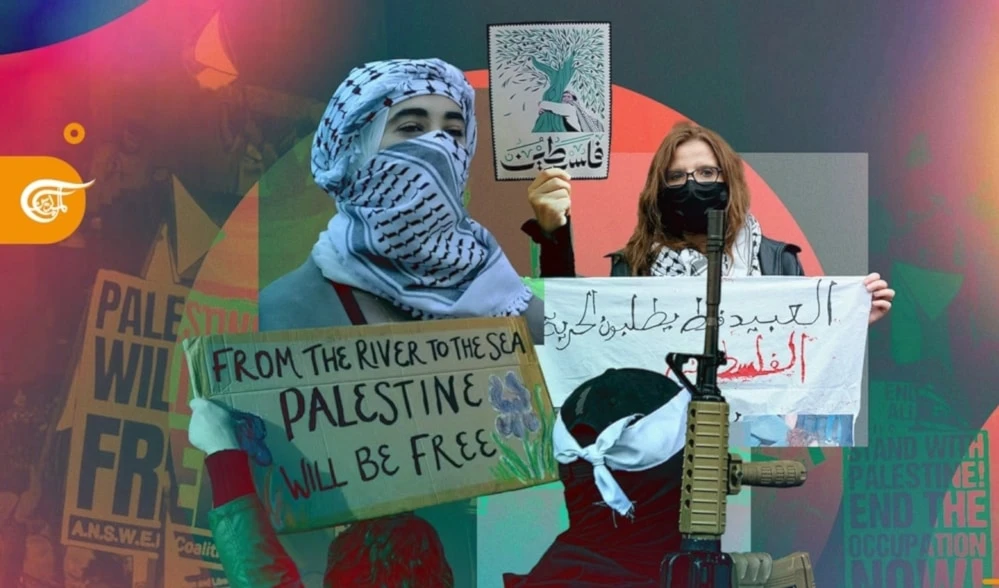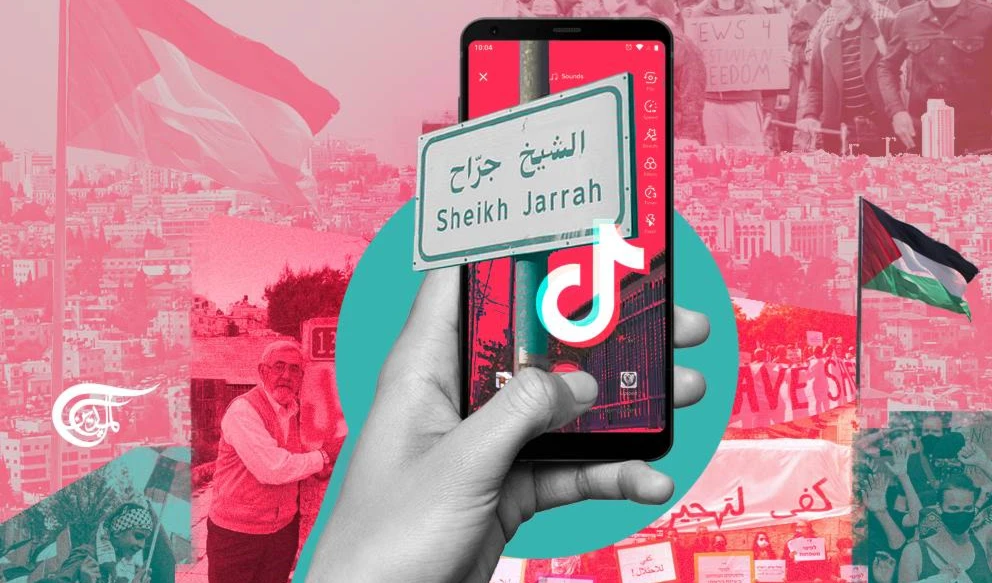From engagement to advocacy, doom scrolling won't stop the Gaza genocide
A flood of content emerged to tell the story of the Palestinian narrative's victory, with pro-Palestinian hashtags outperforming those associated with "Israel." But there is still a plethora of questions surrounding the effectiveness of awareness without actionable change.
-

Doom-scrolling does not help Gaza
A torrent of political, media, and ethical dilemmas has been unleashed by the events of the past few months in light of the genocide in Gaza. One of the most prominent of these dilemmas revolves around the discrepancies in sympathy and advocacy between reality and social media, and the contradictions and insinuations of such that cast a shadow over the global spread of the Palestinian cause and its truths.
There is no doubt that the emergence of social media has played an invaluable role in spreading awareness of the Palestinian cause and highlighting the genocide targeting the Palestinian people. These platforms provided people across the West with a direct link to Palestinians themselves and the situation on the ground, bypassing, to some extent, traditional censorship.
This has allowed Palestinians to reclaim their humanity in the face of a traditional media narrative aimed at dehumanizing them. Many traditional media outlets have long dealt with the Palestinian cause, even before Operation al-Aqsa Flood, with misinformation, lies, and attempts to diminish the value of human life.
These platforms have carried an overwhelming flow of content that reflects the reality of the immense events of recent months, spreading it across the world with full intensity and momentum. One of the most prominent aspects of this has been the widespread labeling of the war as genocide and the continuous reinforcement of this description.
During the war, these platforms contributed to mobilizing global public opinion against the Israeli occupation. They moved from merely challenging the misleading Israeli-Western narrative—an arena in which advocates of the Palestinian cause have historically fought—to becoming a space where the narrative of the "righteous"—and all the emotions, evidence, and facts that accompany it—is solidified.
A flood of content emerged to tell the story of the Palestinian narrative's victory, with pro-Palestinian hashtags outperforming those associated with "Israel." The world witnessed periodic campaigns and calls to punish celebrities who have a massive following and failed to actively voice their support for Palestine.
This is a profoundly significant and influential impact, particularly on younger generations. However, despite its importance, a significant question has overshadowed all these positives, reinforced by the continued genocide and its transformation into an everyday, casual event with all its horrors. This question concerns the adequacy of hashtags, campaigns, and interventions by celebrities in defending the cause.
From this emerges a more embarrassing and morally painful truth: a large number of users have become desensitized to the gory, heart-wrenching content due to the overwhelming flow of information, images, and unlimited access to said content.
The massive and exceptional level of reach and engagement garnered by the massacres the Israeli occupation carried out early on in the genocide compared to the dwindling reach of the perhaps even bloodier massacres that followed suit is evidence of how the situation has been normalized. That is also evidenced by how such topics were outperformed online by holidays, sporting events, and even elections.
Why is advocacy confined to social media?
This is a highly complex question, and comprehensively answering it requires expanding research across various fields, from politics to sociology, and even psychology. However, several indicators have emerged over the months of the genocidal war, revealing the true reasons for this reality. For example:
- The negative impact of exaggerated or inflated stardom on platforms, where influence and results are tied to metrics like content popularity (views, likes, followers, etc.), which ultimately do not change the realities on the ground.
- The oversimplification and spontaneous involvement in a purely consumerist system, tied to which are measurement units and standards, pushing users away from broader thinking about strategic utility and vision.
- The nature of the short memory within the confines of the virtual world—essentially "trendiness"—when addressing serious issues, compared to traditional sources of information, and how this generation's awareness is formed, including the level of engagement and willingness to participate.
- The phenomenon of doom-scrolling or browsing, which is one of the most dangerous and significant indicators, and perhaps it deserves copious review and analysis.
Videos showing shocking scenes of decapitated children, for example, are classified as sensitive or extreme content, which viewers should be warned about before viewing. Therefore, some platforms resort to deleting such content outright. The Western war on Gaza has revealed protests against such censorship, demanding that this content be prevented from spreading or reaching the public. While this may seem logical and consistent with human dignity, it ignores the crime at its core.
These demands have moved to delete videos of mutilated bodies and decapitated heads, but they have not moved to stop the bombing of civilians with one-ton bombs, which, incidentally, are imported from the West itself. The objection here is directed toward the depiction of the crime, without addressing the root of the act, under the pretext that the content itself is being reviewed and filtered before being shown on television screens, for instance.
On TV, you will rarely see a decapitated child, but you will see the same scene on platforms like X or any other social media platform. These scenes are repeated day after day, becoming normal and routine, and no longer shocking to many who have become accustomed to them.
When analyzing the public's stance and the behavior of audiences outside Gaza, we encounter a significant disparity between actual activity and engagement on social media platforms. While these platforms are bustling with documentary content and support for the Palestinian cause, the movement on the ground—whether political, legal, or even media-related—remains far from achieving an impact proportional to the scale, intensity, and brutality of the events, especially in the Arab world. This gap might necessitate extensive deconstructive studies to understand its motivations and interactions.
On one hand, there are those for whom the crime loses its shock value, simply because the scene is sustained and becomes a familiar atrocity rather than a horrifying crime. Such desensitization diminishes the emotional reaction that the initial shock might provoke, followed by a tangible action in its aftermath. This is what every rightful claimant relies on to highlight their injustice. The oppressed not only need an emotional stance, such as sympathy, expressions of regret, or condemnation, but the first and best thing they expect is effective action that changes the reality of their suffering after convincing others of the legitimacy of their cause and the violation of their rights.
Contrary to this is the phenomenon of "doom-scrolling," which involves spending excessive time absorbing a flood of news, particularly negative news, on social media platforms. This can manifest as the excessive consumption of short videos for long periods without interruption. The term was coined in 2020 during the Covid-19 pandemic but has gained exceptional significance now due to the Israeli war on Gaza and the content it generates.
The story of doom-scrolling began with Mark Zuckerberg and Facebook and continues today with dozens of specialized platforms dominated by continuously flowing short videos designed to update every detail of any issue that interests the users or even those that do not.
This relatively new phenomenon in the world of media has allowed Gen Z to carve out a unique space for themselves on these platforms, making them the most active audience engaging with serious issues. This is because they are the generation most in tune with the nature of new technology, which is not entirely new anymore, given that nearly two decades have passed since Facebook's rise.
Scrolling or spending hours without much thought has become so common that the new generation has abandoned many old practices in pursuit of the next click or the content it contains. A new psychological phenomenon has emerged among them, known as the "fear of missing out" (FOMO), where users are so tethered to their phones that they might as well be bound by rope or locked in place, continually checking for any updates that might have taken place over the past minutes or even seconds.
Indirect trauma in the New World
If we were to examine how algorithms work—particularly how they exploit innate human behavior greedily to ensure screen time and higher profit returns, especially concerning the horrific scenes broadcast from the Israeli genocide in Gaza—we would find ourselves dealing with a mental state known as "threat perception."
An internet user might start by browsing their accounts, viewing posts like a friend's party or a neighbor's family trip. Suddenly, scenes from the massacre in the al-Shati refugee camp appear.
With repeated exposure or interaction with these clips, attention is redirected toward seeking more of them. The algorithms then recognize our interest and continue to show us more.
For instance, some people repeatedly expose themselves to painful content from the war on Gaza because it can trigger anger, which helps them reinforce their viewpoints and engage more deeply. Some believe that watching violent news and images puts their nervous system into fight-or-flight mode, as the human brain associates the suffering and killing of people with danger.
Others link the addiction to scrolling and swiping with negative bias, FOMO, and attempts to control uncertainty. Social media platforms, therefore, offer viewers content that they are likely to engage with, creating an echo chamber biased toward their interests and perspectives. This, in turn, generates an open pipeline of content that flows more as viewers engage.
In addition to algorithms, a design feature known as "infinite scrolling" has played a pivotal role in perpetuating this behavior. This feature allows social media users to scroll endlessly, with the algorithm continuously loading new content and creating an endless stream of information.
This is precisely what is happening with Gaza. For anyone using social media platforms, it has become almost impossible to log into their accounts and browse the news without encountering scenes or clips from Gaza. These not-so-innocent tools have reinforced feelings of numbness and inaction, which do not always stem from indifference but can also result from empathy. More specifically, this phenomenon may be a consequence of what psychologists call "empathetic distress"—the feeling of distress when others are harmed, coupled with a sense of helplessness to assist them.
Doctors and experts have long focused on examining indirect trauma and those affected by it, particularly soldiers, journalists, and psychotherapists who deal closely with cases and patients.
However, in an era of rapid communication, and especially because of social media platforms, the discussion around indirect trauma has increasingly centered on the viewer or recipient who spends a significant amount of time browsing content on their mobile phones.
The main reason for this is the inability to control or manage this content. Even when a user decides to skip certain material, it quickly reappears in a different form or from another account. As a result, due to the sheer volume of continuous streams of the Israeli killing machine across hundreds of accounts on various platforms, horrific scenes inevitably find their way to the viewer, even if they intend to avoid them. This is partly due to the ongoing atrocity and the overwhelming availability of graphic content plentiful in blood and dead bodies. Exposure to negative news has thus become a source of "indirect trauma," affecting people even if they are not directly exposed to the traumatic events.
The transition to active advocacy
This all leads to an important conclusion: the necessity of transitioning from merely raising awareness about the realities of the conflict, spreading the just narrative, and combating falsehoods and distorted stories, to achieving effective and active advocacy that drives action, change, and impact in the real world.
Thus, social, popular, and legal activism becomes essential as a path that complements what the virtual world offers, ultimately creating a global community that fulfills its moral duty by directly participating in protests and demonstrations, as seen in Western societies among students or the marginalized. Due to various reasons, these groups, through their natural sense of responsibility, have found it necessary to engage and move to apply pressure or exert any form of influence. Because this pro-Palestine activism is based on information provided by the virtual world, it has the potential to create more organized and politically oriented groups, considering the possibilities of specialization, documentation, coordination, and integration.
There is no doubt that the virtual world is full of loopholes that the Western system can exploit to suppress any activity contrary to its political interests. Alongside the Israeli Prime Minister's talk of a "civilizational war," in which his entity is at the forefront of the "Western civilization's" war on Gaza and the resistance forces supporting it, the methods and techniques of confrontation, both traditional and new, must be integrated into a conscious and harmonious system of resistance. This structure must move systematically to absorb the numbness that virtual empathy might induce and transform it into a true awakening that not only expresses but also leads to real-world action and influence.
Here lies the role of elites in guiding and activating fieldwork by utilizing modern technologies. Political realities are shaped on the ground, not online, although the latter is crucial for generating emotions, beliefs, and opinions, and for affirming them through facts and evidence. Transitioning from the virtual to the real world is necessary to convert empathy into action, and Palestine deserves a great deal of action.

 Bahia Halawi
Bahia Halawi
 13 Min Read
13 Min Read










